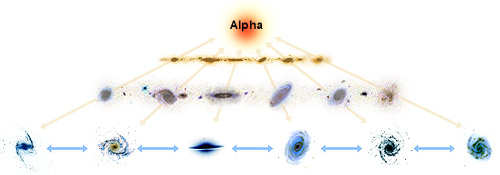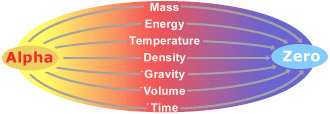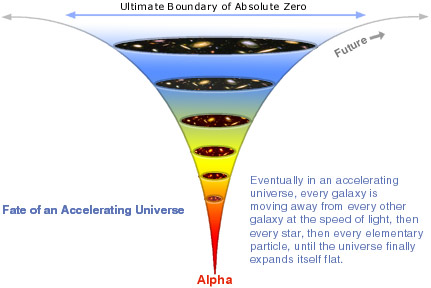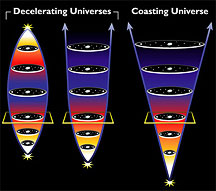|
"In the theory of relativity, the concept of time begins with the Big Bang
the same way as parallels of latitude begin at the North Pole. You cannot go further north than the North Pole."
—Kari
Enqvist
From The Book:
Everything Forever:
Learning to
See Timelessness
"...
it would be helpful if we had a map of all the possibilities. It would be helpful to be able to see all the bends and curves, the contours of potential, to know what lies up ahead, what lies around the corner, and to know the best path to take."
"If we extrapolate this prediction [of contraction] to its extreme, we reach a point when all distances in the universe have shrunk to zero. An initial cosmological singularity therefore forms a past temporal extremity to the universe. We cannot continue physical reasoning, or even the concept of spacetime, through such an extremity. For this reason most cosmologists think of the initial singularity as the beginning of the universe."
—Paul Davies
Physicist and Author
"When you have eliminated the impossible, whatever remains, however improbable, must be the truth."
-Sir Arthur Conan Doyle
" The depth of our penetration into the problem is measured not by the state of things on the frontier but rather how far away the frontier lies. One of the most pronounced examples of such a situation concerns beyond any doubt the nature of time. What we have precisely in mind here is a puzzling discrepancy between our perception of time and what modern physical theory tells us to believe"
--Metod Saniga
The
paradox of limits lies in the fact that limits combine two opposite functions: setting apart and joining." The AllSpark
-Piet
Hut
"Consider the most obvious
question of all about the initial state of the universe: Why is there an
initial state at all?"
-Lawrence Sklar
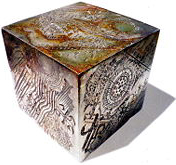
from the Transformers Movie
"...a flat zero space is anything but empty. If it were empty we could put something into it...The most basic rule about flat space is that there is absolutely no way to introduce an object into it without disturbing and destroying it."

"The most important foundational idea of understanding timelessness is that all configurations or possible states (the individual moments of time) physically exist timelessly, because all are merely fragments of an ultimate zero."

|
If we could visually see the timeless realm of possibilities that exists around us we would quickly realize there is a vast unchanging architecture, immense and monumental beyond description, a world that is completely hidden from this world we know. And yet this other realm is actively shaping what is probable and possible for us in time. The American physicist John Wheeler referred to the realm of possibilities as Superspace, and the English theoretical physicist Julian Barbour named the same realm Platonia. Scientists in different fields generally refer to possibilities as state space, phase space, or configuration space. The large-scale realm of all possibilities shapes and governs our universe by producing probabilities, which we face everywhere we turn. Occasionally we hear the odds of winning the lottery, the chance of an earth-quake, or a meteorite striking the earth. We hear of our chance of being in a car wreck compared to that of airplane crashes. By the time we reach adulthood we are all at least vaguely aware of the range of possible events in our lives, beginning with the more probable and ending with the highly improbable to absolutely impossible. In addition to all the ordinary and predictable events, like the sun rising in the morning, there is each day also a chance of something extraordinary happening. We live in a universe governed, shaped, and ruled by possibilities and probabilities so it would be helpful if we had a map of all the possibilities. It would be helpful to be able to see the all bends and curves, the contours of potential, to know what lies up ahead, what lies around the corner, and to know the best path to take. It would be helpful to understand the shape of all possibilities well enough to answer profound but basic questions, such as, why does the possible realm place such limits on what happens in time? Why does it allow such wonder? Why is the probable world so beautiful and exquisitely systematic and orderly, rather than pure chaos? Where are probabilities guiding us? What is certain in the future, if anything? The theme "Learning to See Timelessness" is all about learning to see the possible realm, which includes learning that there is a discernable shape to the whole of possibilities which can be modeled and understood. To learn to clearly see timelessness we first must learn how modern science today models possibilities with what is called the second law of thermodynamics, which sounds like a specific law about temperature, but it is actually a very rudimentary law meant to explain why the universe evolves and changes as it does. Boltzmann’s Version of Overall Possibilities The physicist Ludwig Boltzmann was the first to imagine that the realm of all possibilities has a shape and structure in 1868, as he further developed an understanding of nature that is known today as the second law of thermodynamics. Boltzmann was trying to understand the way that patterns evolve in nature, so he began to consider how an invisible world of possibilities might influence what is probable as the universe evolves and events unfold. He knew for example that gases disperse evenly throughout all available space. He knew that heat does not remain or collect in one area but rather spreads out, moving from warmer to colder bodies. He knew that although it is easy to break objects into smaller disorganized pieces, like a coffee cup or a glass vase, we never see the pieces organize themselves back together, at least not in forward time, as we would see of a broken vase if time were reversed. Why then is forward time different than backward time? Boltzmann concluded the reason is because there are fewer ordered possibilities than disordered possibilities. Boltzmann in his own way explored timelessness by questioning what ultimately exists in terms of possible patterns. He identified a somewhat vague model of what exists timelessly which argues that there are fewer highly ordered patterns compared to the number of disordered patterns. Boltzmann imagined the shape of all possibilities to be similar to this wedge shape shown below, which indicates there must be a state of highest possible order. This state would be the most ordered state in all of reality. Boltzmann's approach turned out to be an incredibly fruitful way of understanding the universe even though he was unaware of much of the scientific and cosmological knowledge we possess today.
No one throughout the course of history would have been more thrilled and amazed than Boltzmann to learn of our big bang past. Today we know the large-scale grouping of stars known as galaxies are moving away from one another, not moving away from any center, but rather all the space between the galaxies is expanding. Space is somehow expanding internally, like the surface of a balloon being inflated with air. Consequently, galaxies twice as far away are speeding away twice as fast from us. The conclusion scientists make is simply unavoidable. We need only imagine turning time backward to realize the inevitable result of letting all the air out of the balloon. If time were reversed all the stars and galaxies would collapse inward on themselves. If we could move into the deep past we would find that our visible universe becomes ever more dense and hot, as every star and galaxy in the heavens is drawn ever nearer. At thirteen point seven billion years into the past the volume of the universe disappears and all material objects are condensed into a single solitary place, a condition scientists often refer to as the Alpha State.
It seems to some unimaginable that all the stars and galaxies in this enormous universe could ever have been crushed to a size smaller than the head of a pin. And yet we can imagine crushing and compressing material into an ever smaller space, the size of an orange, then a walnut, then a pea, and then finally there is a final collapse into what would be an infinitely dense point. Indeed we can imagine it! What is unimaginable is anything beyond that point. Many scientists consider this extreme at the beginning of time to be the most ordered state possible in nature. However, here we are more concerned with the role Alpha plays in our thinking and our ability to imagine. For our discussion here, it matters not if time originated precisely from Alpha. Scientists aren't yet able to state that for certain. What is more important is that such an extreme exists in physics. Simply recognizing there is an extreme of possibility beyond which no other possibilities exist allows us to model timelessness in reference to a boundary. Alpha is not just a place where time may have begun, it is an ultimate boundary state in what is ultimately possible in the realm of all conceivable universes. Ever since there have been philosophers there have been those who argued that the infinite possibilities are boundless. Many people like to imagine that anything is possible, which is tantamount to surmising that the timeless world is incomprehensible. Yet the Alpha state exposes the fact that there is at least one ultimate limitation out there for what can be. There is a distinct boundary in the realm of all possibilities that can be envisioned, and so we can appreciate its influence on our past, which today we call the big bang theory. But we should even think of Alpha as a cornerstone in the foundation of reality itself, a footing, and therefore Alpha deserves the title of Cosmic Absolute, a possibility beyond which no other possibilities exist. Don't Forget Omega Unlike Boltzmann who lived in the later 1800's, today we are fortunate to know the universe is expanding, as this highlights the fact that there are two ultimate boundaries in physics, one located in our past, and one located in our future. If we look toward the future the cosmos is ballooning outward due to cosmological expansion, so the volume of the known universe is becoming ever larger. Which means the density of the visible universe is steadily decreasing and the temperature of the universe is steadily dropping as light and heat waves are stretched and elongated by the expansion of space. If we run the clock forward in the same way that we turn the clock backward to find Alpha, we eventually encounter the extreme physics of absolute zero. We tend to overlook the significance of the great cosmic zero in our future in comparison to the hot and dense Alpha in our past. Very few people are aware that there is a common zero for all measures in physics, a place where mass, energy, density, gravity, and temperature all become zero simultaneously. Absolute zero is more commonly known as the hypothetical temperature at which all motion ceases, a temperature equal to -459.67° degrees on the Fahrenheit scale, or -273.15° degrees on the Celsius scale. There are no temperatures colder than absolute zero. For those who wonder why there can't be a continually colder temperature, the issue of motion is the easiest to understand. At zero all molecular motion would be stopped, in a sense frozen, so hypothetically the passage of time as measured by clocks would stand still.
How near are we to this ultimate zero? The universe seems very warm here on Earth living so near to a star, yet farther out in deep space temperatures are extremely cold. Nearly fourteen billion years of expansion has produced so much empty space between the galaxies that the overall temperature of the universe has been lowered to a minus -454.74° Fahrenheit. The stars and galaxies don't heat the universe to any measurable degree. They are only the remnants left over from our dense and hot past, when there wasn't any space to move around in. Today the greatly expanded universe is only five degrees away from absolute zero on the Fahrenheit scale. In Celsius the universe's temperature is -270.415°C and since absolute zero is -273.15° Celsius, we are less than three degrees away from being timelessly frozen in place. Of course that nasty word cold is just a word we give to a general condition or a certain way the universe behaves. When it comes to getting a sun tan, or taking a bath, we don't much like the extremes of hot either. The future cold seems unfriendly but the density and heat of the Alpha state in our past would crush and melt us. The important point is that our very ideal environment exists between these two extremes, so they both play a very important role in shaping the world we know. Alpha is the extreme of all matter and no space. Absolute zero is the extreme of all space and no matter. Science has given the past a lot of study. But we cannot appreciate our cosmos fully until we learn to appreciate and understand the absolute zero in our future. If time were somehow able to make it all the way to zero the universe would then exist in a state of perfect balance. All the positive and negative particles that make up the physical world would be stretched flat by the expansion of space. All energy would be spent, transformed into space, and time itself would stand still in that place eternally. But is it physically possible for the universe to reach absolute zero?
Considering that ever since the big bang began, ever since time originated from or near the Alpha extreme, the flow of time has always been traveling directly toward zero, it might then seem strange that the future scenario of the universe actually reaching zero has been so neglected throughout history. Physicists are somewhat oblivious to the zero in our future. In a kind of double standard, many physicists have developed elaborate theories of time beginning from nothing, where a random fluctuation in a kind of perfect timeless yet unstable vacuum miraculously created the universe. Heinz Pagels wrote a book titled Perfect Symmetry: The search for the beginning of time. However in regards to time reaching zero in our future, the consensus has been that a matter universe cannot possibly cool all the way and become the ground state of absolute zero. As scientists have developed models of the future most have generally imagined only two scenarios, where the universe would either stop cooling toward zero and collapse inward in a big crunch, and thus heat up again, or what was said to be the more likely scenario, a never ending heat death, where the universe would expand at an ever decreasing rate forever, moving ever nearer to zero without ever reaching zero. Before 1998, science merely lacked enough information to determine if the distant future would be more like "fire" or "ice". Yet we have always known with great certainty that the universe has always expanded and cooled toward zero since time began and thus time is moving ever nearer to zero as if magnetically attracted. Only recently did we discover how powerful the great attraction to absolute zero is. The Collision of Time with Absolute Zero In 1998, a team at NASA, and leading astrophysicists from around the world, made a startling discovery for science entering the new millennium, when they found that the expansion rate for the local universe, compared to the very distant universe, is not slowing as expected, but rather our local expansion is speeding up. Studies of distant Type Ia supernovae clearly indicated that the expansion of the universe is accelerating, and today it is estimated that the expansion of the universe turned from decelerating to accelerating nearly five billion years ago, which is nearly half of the age of the universe. Since that summer, the data has been further verified by multiple teams and studies. And so science now is presently coming to terms with something totally unexpected. In essence, it appears the direction of time is set on a crash course with absolute zero. Does this discovery of accelerating expansion indicate the universe can reach absolute zero? In 2002, in response to Robert Caldwell's paper on dark energy, physicist Brett McInnes of the University of Singapore explored the possibility of a "Big Smash, a final singularity in which the Universe is destroyed in finite proper time by excessive expansion." In March of 2003 Caldwell, a physicist at Dartmouth, already known for his related theory of Quintessence, and two other colleagues, Mark Kamionkowski and Nevin Weinberg, presented what they called the "Big Rip scenario" of the future, which considers the possibility that the dark energy density causing the expansion to accelerate, called phantom energy in this case, mysteriously increases with time. This exponentially growing phantom energy causes the expansion of the spatial universe to literally rip apart all the galaxies, stars, and finally all atoms. In the big rip theory, the evolution of our universe ends distinctly in finite time at what Caldwell also referred to as "the ultimate singularity", a runaway cosmic acceleration that causes our universe to end due to becoming the perfect singularity of empty space, i.e., absolute zero. For myself, the discovery of accelerating expansion was experimental confirmation of what at the time were considered absurd predictions. Before accelerating expansion was discovered in 1998, I wrote three legally copyrighted books, in 1994, '96, and '97 arguing in each that cosmological expansion would stretch space perfectly flat and time will end at zero in a not-so-distant finite future, predictions I made based upon my understanding of timelessness which today is explained fully in my new book. As we speak, accelerating expansion is right now stretching out the curvatures we call gravity and given time it threatens to turn the universe into a flat plane of space, very much like a round balloon that is inflated into a square room, which makes all the surfaces of the balloon perfectly flat and square. Accelerated expansion is how the universe bridges the seemingly infinite gap between increasingly larger circles and the ultimate extreme of perfect flat space (zero). Acceleration is how our unstable past and present becomes the perfect stability of the true vacuum. It will take many billions of years, but eventually all the curvature of matter and energy will be transformed into a perfectly stable zero space. A universe that was once all matter and no space will hence become all space and no matter. That final 'perfectly symmetrical' and 'seemingly empty' space will extend outward infinitely in all directions. It will exist everywhere, everywhen, and be everything. What is this final state of the universe? Zero isn't a world like our world, where things exist separate from one another. Zero is the permanent background, a larger world that exists behind the finite world we experience. Zero is like a whole pie that can be cut into infinitely many different slices, yet is always whole. Zero is timelessness, it is the ultimate top-down viewpoint or omnipresent perspective. In the same way the mathematical zero can be seen as the combination or sum of all the positive real numbers and all the negative real numbers, the cosmological zero in our future is the sum of all possible matter universes combined with all possible anti-matter universes. This final state of our universe is the quantum superposition of all universes of the multiverse. It is a sum of all life, all knowledge, all information, all that we were, are, and become. It is the one great infinite sum, the implicate whole, the ultimate singularity, which is why it is so much larger than the past, infinitely expanded, stretching infinitely in all directions. The physically real zero in our future is literally everything forever.
Once time reaches zero, all that remains is a perfect multidimensional space that extends outward infinitely in all directions, and yet such distances are suddenly meaningless from our perspective living in a world of many things, because we can only measure distances in relation to things in space. So that whole is suddenly everywhere at the same time. How should we imagine this final state? Is it physically real? The biggest step in appreciating zero is getting past our expectations and assumptions. First, we couldn't be more wrong in assuming that zero or empty space is nothingness. Zero is the ultimate singularity, but singularities are just the sum of many things combined together into a single whole, or many things combined into one thing. This is why the Alpha state of the big bang is a singularity. The point of the big bang is a singularity because all the density of stars and galaxies are crushed and melted together into one thing. Likewise, the zero in our future is a combination of many things; for example it is a combination of all the possible moments, and all such moments are unified together into a superspace. The superspace of zero looks like nothing at all to us because it is a uniform and smooth singularity, but it is actually simply oneness. All universes and all lives are all fragments of one great super whole. The Direction of Time's Arrow Contrary to modern expectations about the past, there is no reason, no known fact or evidence, that indicates an ultimate zero somehow existed before Alpha and the dense physics and heat of the big bang. There is the unsolved mystery of why time begins at all, but there is no science that indicates an ultimate zero somehow created the universe. Instead we distinctly see an absolute zero in our future. Science presently does not have an answer to why time suddenly began from the conditions of Alpha. The big bang is not such a theory, it is merely a recognition that all the galaxies are expanding away from one another, and the obvious consequences of that fact. Those consequences lead us to a recognition that the extreme state of Alpha exists in our past. So strictly imagining what we know, we actually realize that the early conditions of the big bang move us toward the high end of physics; approaching infinite mass, infinite energy, infinite density, and infinite heat. It really doesn't make sense to look for zero in the past, because absolute zero so plainly exists entirely at the other end of the scale. Absolute zero is the extreme bottom end of physics. Surprisingly, in reverse of what we insistently expect of the universe, the seeming nothingness of zero is plainly evident in the direction of our future, and not the past. Why is this? What is a seeming ultimate state of nothingness doing in the future?
If
we now take a major step backward and consider how the universe has evolved from its beginning to present, which is one
of the advantages of being able to step outside of time, we see that time began from, or time began very near to, an
infinitely hot Alpha, and then the universe expanded and cooled for billions of years until it has almost reached Omega.
The evolution of time of our universe spans across the whole spectrum of possibilities like a clothes line in between
two poles. Imagine all the alternative directions for time to travel in. How relevant is it that time travels away from
one extreme of an infinite hot and dense positive curvature, all the way to the other extreme of the absolute cold, zero
density, and perfect flatness of Omega? Is there a discernable reason that this is the natural course of time for our
universe?
Over the last 100 years, discovering the universe is expanding away from the extreme of Alpha taught us a great deal about the past, but only recently, due to the discovery of accelerating expansion, are we discovering the role that absolute zero plays in our future, as well as considering the influence of a future zero on the present. Science is not only coming to terms with the real and likely possibility that in many billions of years in the future there is an abrupt edge to time that ends at Omega zero. We are also beginning to focus on the physically real properties of zero, so we are beginning to discover what zero actually is. The stage we are in now is quite similar to the period between 1910 and 1932 when Vesto Slipher began measuring the red-shifting of galaxies and when Edwin Hubble showed the universe contained many different galaxies all expanding away from one another. It was many years before the majority of scientists fully appreciated what the expansion of galaxies meant about the past, but that one piece of knowledge has led to virtually everything we presently understand about the evolving large-scale cosmos. Simply recognizing that there is an extreme in the past taught us a great deal about the universe. Recognizing there is another extreme in our future will lead us to a scientific understanding of the universe and life beyond what we expect is even possible.
Figure 9 Today many physicists believe many different pasts and futures
are possible As we continue now we will be confronting the mystery of why time travels from Alpha to Omega. There is actually a very simple and comprehensible reason why time travels toward zero. We shall discover that there is always a single place from which time originates, an Alpha state. This is true for all possible universes. Any observer existing in time in any universe will trace the origin of time backward to an infinitely dense point, just as we do, and thus also determine that their history included a big bang event. All observers will also witness accelerating expansion in the later evolution of their own universe, and each universe will accelerate toward the Omega of zero where time ends. This is the natural course of time for all universes. It is possible to know this, to understand that the laws of nature and the parameters of space-time precisely as we know them, are not arbitrary, but rather are elementary to the whole of what exists. This can be learned if we develop a clear and precise model of all possibilities. Welcome to excerpts from the book Everything Forever: Learning to See Timelessness. This website is a rewritten and shortened version of the book and is available online. The book is very similar, but of course there are lots of interesting details and whole sections not presented here that are included in the 348 page book that includes over 200 photos and illustrations, as well as the details of how and why a universe can exist timelessly. In this shortened version the next step is to clearly understand the hidden order and content that exists within absolute zero. What follows in part two is the magical key that unlocks a very clear understanding of the shape and structure of the infinite and timeless big picture. A few other people, such as the physicist David Bohm, once a student and friend of Albert Einstein, also recognized these two kinds of order. The writer and Nobel laureate Henri Bergson also recognized the two orders, just not as clearly as what is about to be explained. Part Two: Discovering the Two Opposing Types of Order This essay last updated Mar 7th, 2007 |
| Your welcome to send an e-mail and share your thoughts when you're done reading. |
|
Homepage | Part One | Part Two | Part Three | Part Four | Part Five | Contents | Backward | Forward | |
|
© Gevin Giorbran, Copyright 1996 - 2007 All rights reserved. Privacy Policy | Usage Policy |
|
|
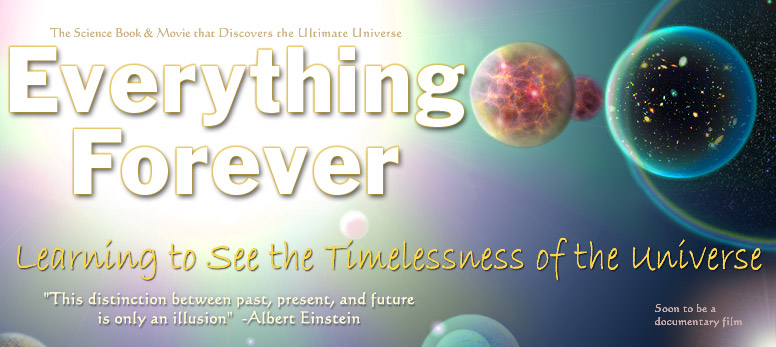
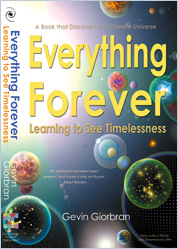
 Part
One
Part
One
